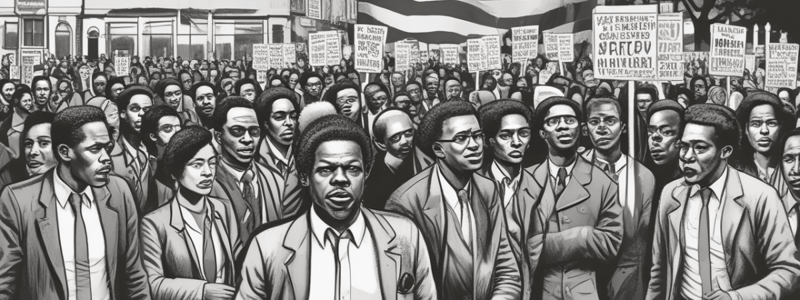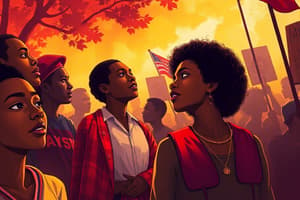Podcast
Questions and Answers
Where was Philip Randolph born?
Where was Philip Randolph born?
- Chicago, Illinois
- Crescent City, Florida (correct)
- Washington, D.C.
- New York City, New York
What motivated Philip Randolph to take action?
What motivated Philip Randolph to take action?
- He was inspired by his acting career
- He was influenced by his family values
- He was influenced by his friends' values
- He was upset by the way Black workers were treated (correct)
What was the name of the magazine co-founded by Philip Randolph in 1917?
What was the name of the magazine co-founded by Philip Randolph in 1917?
- The Brotherhood
- The Messenger (correct)
- The Laborer
- The Unionizer
What was the focus of the National Brotherhood of Workers of America?
What was the focus of the National Brotherhood of Workers of America?
What was the occupation of many formerly enslaved people in the train car industry?
What was the occupation of many formerly enslaved people in the train car industry?
Who founded the Pullman Company in 1867?
Who founded the Pullman Company in 1867?
What was the goal of the Brotherhood of Sleeping Car Porters?
What was the goal of the Brotherhood of Sleeping Car Porters?
What was the name of the organization that Randolph served on the board of in 1919?
What was the name of the organization that Randolph served on the board of in 1919?
What was the initial occupation of Philip Randolph?
What was the initial occupation of Philip Randolph?
Why did the Department of Justice label The Messenger magazine 'dangerous'?
Why did the Department of Justice label The Messenger magazine 'dangerous'?
What was the main provision of the Railway Labor Act of 1926?
What was the main provision of the Railway Labor Act of 1926?
What was the result of the agreement between the Pullman Company and the Brotherhood in 1937?
What was the result of the agreement between the Pullman Company and the Brotherhood in 1937?
Why did Randolph plan to march on Washington in 1941?
Why did Randolph plan to march on Washington in 1941?
What was the outcome of President Roosevelt's actions in response to the planned march on Washington in 1941?
What was the outcome of President Roosevelt's actions in response to the planned march on Washington in 1941?
Who was a key figure in the modern civil rights movement and worked alongside Randolph in organizing the March on Washington movement?
Who was a key figure in the modern civil rights movement and worked alongside Randolph in organizing the March on Washington movement?
Why was Bayard Rustin removed from many leadership positions in the 1960s?
Why was Bayard Rustin removed from many leadership positions in the 1960s?
What was the key idea emphasized by respectability politics in the civil rights movement?
What was the key idea emphasized by respectability politics in the civil rights movement?
What is the main idea of the phrase 'the real freedom means everyone gets free'?
What is the main idea of the phrase 'the real freedom means everyone gets free'?
What is the main characteristic of the civil rights movement described in the text?
What is the main characteristic of the civil rights movement described in the text?
What is the significance of the March on Washington movement to the civil rights movement?
What is the significance of the March on Washington movement to the civil rights movement?
Flashcards are hidden until you start studying
Study Notes
-
Philip Randolph, the father of the March on Washington movement, was born on April 15, 1889, in Crescent City, Florida, and raised in a home that instilled in him values of human rights and equal rights for Black Americans.
-
Randolph's early life involved working odd jobs and trying his hand at acting, particularly in the works of Shakespeare, but he became increasingly upset by the way Black workers were treated and decided to take action.
-
In 1917, Randolph founded the Messenger magazine with Chandler Owen, which urged Black people to demand higher wages and better working conditions, and became so influential that the Department of Justice called it "the most able and the most dangerous of all the Negro publications".
-
Randolph also got directly involved in organizing, starting with unionizing elevator operators in New York City in 1917, and later serving on the board of the National Brotherhood of Workers of America in 1919, which aimed to improve working conditions and fight discrimination.
-
In 1925, Randolph was elected the general organizer of the Brotherhood of Sleeping Car Porters, which marked the beginning of his efforts to gain full inclusion into the American Federation of Labor.
-
The Pullman Company, founded by George Pullman in 1867, monopolized the train car industry and employed many formerly enslaved people as porters, but they had little rights or representation, leading Randolph to take action.
-
In 1926, Congress passed the Railway Labor Act, which helped the Brotherhood's efforts by mandating negotiations between labor and management over wages and working conditions.
-
Despite facing opposition, including from some Black leaders, Randolph's efforts eventually led to the Brotherhood receiving an international charter from the American Federation of Labor in 1935, and the Pullman Company signing the first-ever agreement between a union of African-American workers and a major American corporation in 1937.
-
The agreement secured a 240-hour work month, eliminated the practice of determining rates by mileage, and secured a reasonable amount of rest during trips for Pullman porters.
-
In the lead-up to America's entry into World War II, Randolph believed that Black men should not be forced to join a segregated army, and planned to march on Washington in 1941, which was believed to attract over 100,000 people.
-
To placate the activists, President Franklin D. Roosevelt issued Executive Order 8802, banning racial discrimination at government defense industries, and established the first Fair Employment Practices Committee (FEPC) to investigate complaints of discrimination.
-
Although Roosevelt's actions only banned segregation within war industries, many activists saw it as a win, and Randolph continued the March on Washington movement to hold the FEPC accountable.
-
In the summer of 1942, the March on Washington movement organized a series of mass public rallies, and Randolph's original 1941 plans became the direct inspiration for the 1963 demonstration.
-
Bayard Rustin, a key figure in the modern civil rights movement, worked alongside Randolph in organizing the March on Washington movement, and was a devout student of Gandhi's teachings.
-
Rustin helped introduce Dr. Martin Luther King Jr. to the practice of non-violent interracial organizing and participated in a predecessor of the Freedom Rides.
-
However, Rustin's contributions were often overshadowed due to his sexual orientation, and he was removed from many leadership positions in the 1960s, including during the organization of the 1963 March on Washington.
-
The decision to remove Rustin was shaped by respectability politics, which emphasized presenting a certain image of Blackness to gain basic human dignity and respect.
-
The real freedom means everyone gets free, no matter how they dress, talk, their level of education, or who they love.
-
The civil rights movement was a collective effort involving people of all ages and backgrounds.
-
Social movements, including ongoing ones, rely on the support of people from all generations to achieve success.
-
Key figures like Philip Randolph and Bayard Rustin played crucial roles in the civil rights movement, contributing to the development of Martin Luther King Jr.'s leadership.
-
Thousands of individuals contributed to the civil rights movement, making it a diverse and multifaceted effort.
-
The movement's success was dependent on the collective efforts of all its participants, with every individual playing a vital role.
Studying That Suits You
Use AI to generate personalized quizzes and flashcards to suit your learning preferences.




